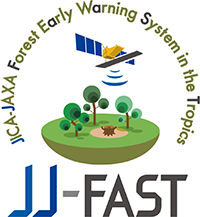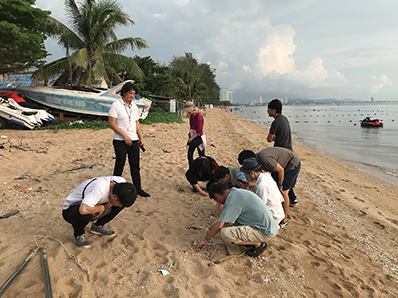(3) Promotion of Information and Communications Technology (ICT), Science, Technology, and Innovation, and Research and Development

The JICA-JAXA Forest Early Warning System in the Tropics (JJ-FAST) uses JAXA’s DAICHI-2 (Advanced Land Observing Satellite-2) to monitor tropical forests in 77 countries every 1.5 months (See also “Outer Space”)
The dissemination of Information and Communications Technology (ICT) Note 13 contributes to the upgrading of industry and improvement of productivity. It also contributes to solving social issues of medical care, education, energy, environment, disaster risk reduction, and other areas, and helps promote democratization by encouraging information disclosure and establishing broadcasting media. Moreover, the importance of Digital Transformation (DX) Note 14 is increasing under the spread of COVID-19.
● Japan’s Efforts
■ Information and Communications Technology (ICT)

Training through the “Project on Capacity Building for Cyber Security in Viet Nam” (Photo: JICA)
Japan promotes “quality infrastructure investment” in the ICT field in developing countries. Note 15 It actively supports the establishment of telecommunications and broadcasting equipment and facilities, the introduction of the technology and systems they require, and relevant human resources development. Specifically, Japan actively works to support the overseas spread and introduction of the Integrated Services Digital Broadcasting-Terrestrial (ISDB-T), Note 16 which has been adopted in a total of 20 countries Note 17 in Latin America and the Caribbean, Asia, Africa, and other regions as of December 2021. In addition, JICA training programs are conducted every year for countries adopting or considering ISDB-T. The Ministry of Internal Affairs and Communications (MIC) also promotes assistance that offers ICT solutions to resolve social issues by way of dialogues and joint projects with partner governments.
Japan works with the International Telecommunication Union (ITU) Note 18 to provide a variety of development assistance in the fields of telecommunications and ICT to developing countries. In October 2020, under the spread of COVID-19, Japan cooperated with the ITU to launch Connect2Recover (C2R), which supports developing countries and regions mainly in Africa to draft national strategies for strengthening digital infrastructure and improving their usage environments. In 2021, Japan provided support for the first phase of internet connection in Rwandan schools (10 out of 63 pilot schools) under the “Giga” initiative jointly implemented by ITU and UNICEF.
In the Asia-Pacific region, the Asia-Pacific Telecommunity (APT) Note 19 contributes to the balanced development of the telecommunication services and information infrastructure in the region. In order to promote human resources development related to telecommunications, Japan finances a number of training programs conducted by APT every year. In FY2020, seven training programs regarding issues such as broadband networks and cybersecurity were implemented and attended by approximately 120 people from the APT member states. The trainees utilize Japanese technology for the development of their own countries’ ICT, and Japanese companies’ expansion into the Asia-Pacific region is also expected through introducing Japanese technology systems.
In the Asia-Pacific region, over two billion people do not have internet access due to factors including fragile infrastructure and the inability to afford it. In the Association of Southeast Asian Nations (ASEAN) region and Pacific Island countries, Japan provides support to develop low-cost, high-speed internet connectivity to remote islands and areas.
On December 12, 2021, Japan, the United States, Australia, the Federated States of Micronesia, Kiribati, and Nauru issued a joint media statement titled “Improving East Micronesia Telecommunications Connectivity.” For the purpose of strengthening telecommunications infrastructure and supporting increased economic growth in the region, in response to the requests from the three Pacific island countries, Japan, the United States, and Australia, in cooperation with the World Bank and the Asian Development Bank (ADB), will support a project to build a new undersea cable. Japan will continue to support the development of quality infrastructure in the Indo-Pacific region in order to realize a “Free and Open Indo-Pacific (FOIP)” in cooperation with the United States, Australia, and other like-minded countries.
With regard to the issues of cyber-attacks that have become key concerns of countries in recent years, Japan and ASEAN have agreed to further strengthen their cooperation. Note 20 As a specific initiative, the ASEAN-Japan Cybersecurity Capacity Building Centre (AJCCBC) was established through the Japan-ASEAN Integration Fund (JAIF) and conducted cybersecurity exercises and other efforts (see “Cyberspace” for details).
■ Promoting Science, Technology and Innovation, and Research and Development

Visit to the Thai coastline for the project under the SATREPS “Formation of a Center of Excellence for Marine Plastic Pollution Studies in the Southeast Asian Seas” (Photo: JICA) (See also “Master Techniques from Japan to the World”.)
The Science and Technology Research Partnership for Sustainable Development (SATREPS) program,* Note 21 which links ODA and the science and technology budget, was launched in 2008 to support joint research between research institutions and researchers in science and technology fields in Japan and developing countries. 168 research projects in 53 countries around the world have been adopted by FY2021 (see also “Master Techniques from Japan to the World 3”, “Master Techniques from Japan to the World 4”).
Based on cooperation for human resources development, Japan develops networks among the next generation by strengthening assistance for overseas engineering universities.
In Asia, Japan provides support to the Malaysia-Japan International Institute of Technology (MJIIT) by procuring equipment and supplies for education and research as well as developing curriculum designs. As of 2021, Japan also collaborates with 28 universities and two research organizations in Japan to extend cooperation for establishing educational curriculums, dispatching Japanese faculty, and other objectives (see also “ODA Topics 5” for Malaysia’s Look East Policy). Since 2012, Japan provides scholarships to students studying remote sensing (satellite image analysis) in courses taught by Japanese instructors at the Asian Institute of Technology (AIT) Note 22 located in Thailand, contributing to the development of the human resources who will constitute the crux of the space industry development in the Asian region.
In Egypt, Japan has continued to support the Egypt-Japan University of Science and Technology (E-JUST) Note 23 since 2008. With the cooperation from universities in Japan, in addition to providing support for the operation of graduate schools and departments, such as the provision of practical and international-standard engineering education and promotion of joint research with the industrial sector, Japan also supports the acceptance of exchange students from the Middle East and Africa regions, contributing to industrial and science and technology human resources development in the regions.
- Note 13: See Note 5.
- Note 14: See Note 6.
- Note 15: In 2017, Japan formulated the Playbook for Investment in “Quality ICT Infrastructure” for ICT policymakers and procurement managers of the respective countries and regions.
- Note 16: ISDB-T is a terrestrial digital broadcasting system that was developed in Japan. Its functions, such as emergency alert broadcast, TV reception on mobile terminals, and data broadcasting, give the system advantages in disaster response and the provision of diverse services.
- Note 17: The 20 countries are Japan, Brazil, Peru, Argentina, Chile, Venezuela, Ecuador, Costa Rica, Paraguay, the Philippines, Bolivia, Uruguay, Botswana, Guatemala, Honduras, Maldives, Sri Lanka, Nicaragua, El Salvador, and Angola (as of December 2021).
- Note 18: A UN specialized agency, which covers the fields of telecommunications and broadcasting. To ensure that people around the world are able to make use of telecommunications technologies, ITU organizes the following: (i) international allocation of radio frequencies used in mobile phones, satellite broadcasting, and other technologies, (ii) international standardization of telecommunications technologies, and (iii) support for development in the field of telecommunications in developing countries.
- Note 19: An international telecommunication organization established in the Asia-Pacific region. Aiming for a balanced development of telecommunication services and information infrastructure in the Asia-Pacific region, it implements human resources development through training courses and seminars, and coordinates regional policies on standardization, wireless communications, and other telecommunication issues. In 2020, Mr. KONDO Masanori was elected as the Secretary General.
- Note 20: In 2015, the Cybersecurity Strategic Headquarters was established in the Cabinet Secretariat, and in 2016 the “Basic Policy to Support Cybersecurity Capacity Building in Developing Countries” was reported to the Headquarters.
- Note 21: See also Part IV 1(5).
- Note 22: One of the Asia’s leading graduate schools offering master’s and Ph.D. programs at the School of Engineering and Technology, the School of Environment, Resources and Development, and other faculties.
- Note 23: A public university based on the concept of providing graduate school, research-centered, pragmatic, and international-standard education for a small number of students, drawing on the features of Japanese-style engineering graduate school education.
